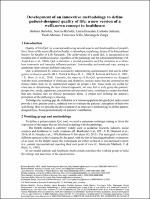Chapter Development of an innovative methodology to define patient-designed quality of life: a new version of a wellknown concept in healthcare
| dc.contributor.author | Bertoldi, Serena | |
| dc.contributor.author | Sofia, Francesca | |
| dc.contributor.author | Bartolini, Barbara | |
| dc.contributor.author | Benedan, Laura | |
| dc.contributor.author | Galeone, Carlotta | |
| dc.contributor.author | Mariani, Paolo | |
| dc.contributor.author | Zenga, Mariangela | |
| dc.date.accessioned | 2022-09-15T20:05:38Z | |
| dc.date.available | 2022-09-15T20:05:38Z | |
| dc.date.issued | 2021 | |
| dc.identifier | ONIX_20220915_9788855184618_18 | |
| dc.identifier.issn | 2704-5846 | |
| dc.identifier.uri | https://library.oapen.org/handle/20.500.12657/58222 | |
| dc.description.abstract | Patient quality of life (QoL) is a pivotal parameter, which is often used by clinicians to evaluate how treatments and therapies influence patients’ functionality and emotional state, aiming to ameliorate interventions and their outcomes. Currently, the majority of questionnaires assessing the QoL are designed with the main contribution of clinicians and, therefore, include items that are cantered on the disease rather than on its multifaceted impact on people’s life. The failure to truly grasp the patients’ perspective, their needs, aspirations, perceptions and emotional state, is a major drawback that sets medical care on clinical parameters alone. We aimed to bridge this gap by establishing an innovative patient-designed QoL index to provide a new, unbiased tool considering the patients’ perception of their own well-being. Based predominantly on patients’ contribution, we defined specific areas (physical, emotional, social, functional, economical) and the respective characterizing features, and applied a pseudo-Delphi methodology combined with customer-satisfaction techniques. For each feature, the degree of agreement and the importance were assessed on a Likert scale. A synthetic QoL index was created by weighting the importance of each item. The methodology tested led to the development of a valid patient-designed QoL index, providing a way forward that could potentially be applied to many different conditions. The areas and the features included are indeed common to all patients, irrespective of their disease. We found that the process of methodology development enhanced the patients’ awareness of their subjective experience with the disease, and enabled them to better present their situation to the clinicians. The patient-designed QoL index provides a descriptive model that can be helpful to patients, clinicians and third parties and that can be further integrated with clinical details to obtain an overall view of the course of treatment for each patient. | |
| dc.language | English | |
| dc.relation.ispartofseries | Proceedings e report | |
| dc.subject.classification | thema EDItEUR::J Society and Social Sciences::JH Sociology and anthropology::JHB Sociology::JHBC Social research and statistics | en_US |
| dc.subject.other | Quality of Life | |
| dc.subject.other | QoL | |
| dc.subject.other | Pseudo Delphi | |
| dc.subject.other | Methodology | |
| dc.subject.other | Patient awareness | |
| dc.subject.other | Patient experience | |
| dc.title | Chapter Development of an innovative methodology to define patient-designed quality of life: a new version of a wellknown concept in healthcare | |
| dc.type | chapter | |
| oapen.identifier.doi | 10.36253/978-88-5518-461-8.30 | |
| oapen.relation.isPublishedBy | bf65d21a-78e5-4ba2-983a-dbfa90962870 | |
| oapen.relation.isbn | 9788855184618 | |
| oapen.series.number | 132 | |
| oapen.pages | 5 | |
| oapen.place.publication | Florence |

